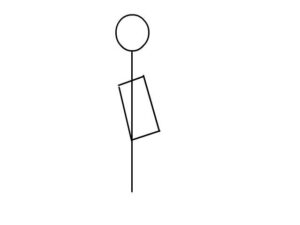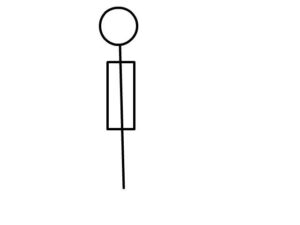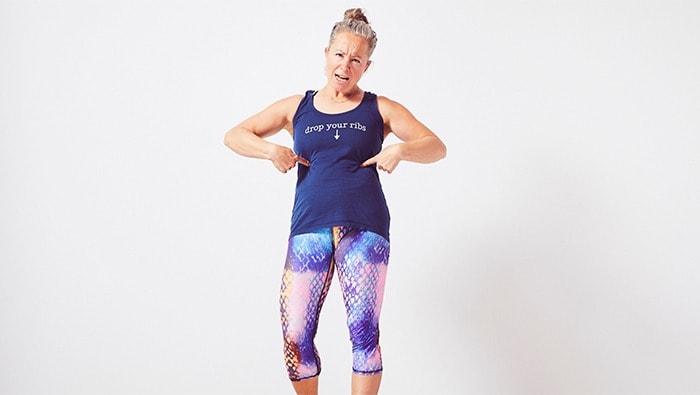UPDATED: February 28, 2025
One of the biggest alignment issues that most of us share is what we call rib thrusting. Due to massively tight psoas muscles and widespread hyperkyphosis (overly curved upper backs), many people push the bottom of the ribcage forward and pull their shoulders back. This hides the problem, visually, but wreaks havoc on your health since it means that you can’t breathe right, you’re overloading some parts of your spine, you can’t use your core muscles effectively, & you’re setting yourself up for a heart attack. It looks kinda like this:

The bottom ribs poke out and the mid-back becomes sore and tight as the muscles shorten.
An aligned rib cage looks more like this:

How Do You Know If You’re Thrusting Your Ribs?
There are two easy ways to check.
1️⃣ Try using your hands to feel the bottom of your rib cage, just over your belly button. If you can feel the edges of your ribs poking out (or see them, even), then your ribs aren’t where they should be.
2️⃣ Place yourself sideways to a mirror. Place a hand flat on your sternum, fingers pointing up. Is that hand vertical, or is the wrist way out in front of the finger tips? A vertical hand is an indicator that your ribs are where they should be.
This is what a rib thrust looks like, if you happen to be a bit hairy:

Can you see how the bottom ‘corners’ of my models ribs are flaring out?
And this is what ribs down look like (but in this picture, my model is forcing his ribs down – exactly what you don’t want to do in real life. You can see that his abs have to work to do this demonstration – it’s literally like doing a curl-up, except standing).

My model is super skinny, so you can still tell that he has a rib cage, but the lower edges are more ‘sunken’ into his torso.
Why It’s Hard To Fix
It’s basically pretty simple to get your ribs back where they belong – you just have to stop pushing them out. But there are a few barriers along the way.
1️⃣ Dropping your ribs reveals how tight your shoulders have become and how far your head has travelled forward. Most people find that seeing this is not very enjoyable.
2️⃣ Although holding your ribs up may be an (unconscious) postural choice, it might also be because your psoas muscles are really tight and short. If this is the case, then putting your ribs where they belong might be a lot of work for you, because you’ll be using your abdominal muscles to pull against the tightness in your psoas muscles. That’s what’s happening in the second picture above.
Start healing your pelvic floor, building a functional core & caring for your spine (for free!)
What To Do To Solve The Problem Without Creating New Issues
You need to fix the issue gently, and step by step. This means:
1️⃣ Do drop your ribs, but only as much as you can without forcing anything. Check in with your belly – if you have to turn on your abs to drop your ribs, you’ve gone too far.
2️⃣ Start doing some shoulder stretching. The more mobility you have in your shoulder joints, the less your spine will have to help out (and the less like a hunchback you’ll feel when you drop your ribs).
3️⃣ Make releasing your psoas your #1 movement priority until it is easy to drop your ribs back where they belong when you are standing.
Remember, the key here is that you don’t need to go all the way immediately. Drop your ribs as much as you can without effort (let go of any mental or emotional ‘holding’ that you’re doing) and then work on shoulders and psoas muscles to allow your body to ease into better alignment, naturally.
I Dropped My Ribs But Now I Feel Like Quasimodo
Getting the ribs down – forced or unforced – will expose the terrible shoulder tightness we all have from our years of not moving our arms to do anything except typing. This can be one of the hardest (mental and emotional) parts of getting your ribs into alignment. But it is an important first step, and the good news is that you can fix it by working on your shoulders. This in turn will improve the health of your entire upper body, including your breathing, your shoulder health (obviously), and your head, neck and jaw.
Want to learn more about why ribcage position is SUPER important? Make sure to check out my free 5 part video series, Ribcage Magic, where I’ll help you do a quick self-check of your own ribcage alignment and figure out the ideal rib position.







